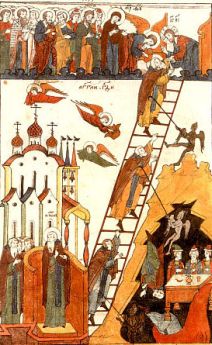|
From 'Orthodoxy and the World' www.pravmir.com Fasting Source: Annunciation Greek Orthodox Church
During the remaining period of Great Lent, there are two particular Sundays on which I would like to focus. The first of these Sundays, which is the fourth Sunday of the Fast, is dedicated to the memory of St. John Climacus, or St. John of the Ladder.
St. John is commemorated during Lent because of his great spiritual work called The Ladder of Divine Ascent. Although this work was written specifically for the monastic world, the author being a monk himself, St. John’s “Ladder” is a classic work of Orthodox spiritually that speaks to all members of the Church, in all places and in all times. His book presents us with a spiritual ladder ascending to heaven, with each rung representing a particular vice or passion to be conquered in order to proceed upward. The approach is very straightforward and logical, being that going that next step in our spiritual growth necessitates overcoming the sinful obstacles, which have kept us in the state where we presently find ourselves.
An important part of understanding our spiritual lives as an ascent, is the possibility of falling down a few rungs, or even completely off the ladder, which is the reality that we constantly face. In fact, the classic icon of St. John and his ladder clearly depicts the successful ascent of those truly holy and spiritually advanced monks, versus those who have succumb to various passions, causing them to fall into the pit of hell.
The following Sunday, the fifth Sunday of the Fast, we commemorate our Venerable Mother, Mary the Egyptian. This former prostitute who sought tearful reconciliation with Christ and became a desert wanderer in order to live out her repentance, is the example par excellence, of the repentant sinner. Her story is quite moving, and very motivating to anyone who is unrepentant and continues to carry the burden of sin.
The Church, in Her Spirit-filled great wisdom, places the memory of St. Mary of Egypt on the last Sunday of Great Lent, as a spiritual “wake-up” call to us to finish the race and accomplish the goal of sincere repentance. If we have truly made some serious efforts during Great Lent, then we hopefully have reached the point of repentance which will lead us to the holy mystery of confession, prior to the celebration of the Lord’s passion and resurrection. We must remember that repentance and confession are key components of the spiritual life, because without them there is no true spiritual life, but only a meager attempt, at best.
So thus, Great Lent comes to a close during the week after the Sunday of St. Mary of Egypt. Specifically, Lent ends on the following Friday at the reading of the 9th hour, immediately preceding the vespers of St. Lazarus, included in the service of the Presanctified Gifts. Many of our faithful do not realize that the forty day fast ends on this particular Friday, and that Holy Week is separate from Great Lent, standing on its own as a solemn week of strict fasting in commemoration of the last days of our Lord on earth. This is important to know, because the focus of Great Lent and Holy Week are different.
Great Lent is a time for deep, personal reflection. The entire spirit of the forty day fast, is that of an intense spiritual journey that brings us back to God through our spiritual efforts, in order to be properly prepared for Holy Pascha, the greatest of all feasts. In contrast, Holy and Great Week is totally focused on the Lord and His passion and burial, hence the strict fast. In Holy Week, we follow the Lord during His last days, and hear his final teachings and warnings about the Kingdom of Heaven and His second glorious coming to earth for the final judgment. As we all know and have experienced each year, the darkness of Holy Week gradually gives way to the brightness and joy of the Resurrection. This is most profoundly exemplified in the Orthros of Holy Saturday, popularly known as the Epitaphios Lamentation, celebrated on Holy Friday evening.
Beloved in Christ, our Orthodox Church is at its absolute best, so to speak, during Great Lent and especially Holy Week. This is not to say that there is anything inferior about the remainder of the liturgical year, which in reality, is actually a reflection of Holy Pascha, which gives light and life to everything we do in the Church. It is precisely because of the magnitude of the feast of Pascha, that such liturgical beauty experienced through hymnography and ritual is presented to the faithful for their spiritual edification.
May we all take advantage of what remains of Great Lent, and thus, be prepared to enter Holy and Great Week with eager anticipation and love for the Bridegroom Christ. This should be the highlight of the year for each and every Orthodox Christian who truly loves the Church.
© Copyright 2004 by 'Orthodoxy and the World' www.pravmir.com |
